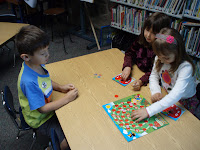
I use a variety of sources to develop the K/1 math program. I get materials from the web, books, various math programs, and my most valuable resource: other SK teachers.
Everyone in the school does math at 9:00 each day. Generally, in our class, the math lesson starts with a group lesson, in which I introduce new math concepts and practices using ideas already learned. These sessions include me talking and the children doing. For young children to have a true understanding of what they are learning, they must have concrete hands-on experiences. To illustrate how this works in practice, here is an example from a lesson this week. On Wednesday, we discussed ordinal numbers. First, I wrote the numerals and words on the board (1st=first...10th=tenth).
Next, I told the children what position they would be in a line and they lined up accordingly. In the next activity, the children got a handful of colored bears, which they put in a line. I asked, “who has a red bear?” and the children with red bears told us what position their red bear was in their line. The other thing this example shows is how reading and new vocabulary can be incorporated into a math lesson.
Another important part of math is encouraging the children to deduce and problem solve. A very quick example of this was an exercise where the children walked from the rug to their chair taking “baby steps”. I wrote on the board how many steps each child took, ranging from 16 to 40. I asked why there was a difference. Several children came up with the idea that it was because the chairs were different distances from the rug and that some people walk around more before they got to their chairs.

After the group lesson, the children work in Singapore Math books usually for between 10-20 minutes. For some children it is the first time they will be using a workbook. For these children they must first learn the basic convention of filling in a space or a line with an answer. Once they have this down the Singapore books can be used fairly independently. An idea is introduced in the “text book” and practiced in the “work book”. This math series provides an introduction to a variety of mathematical concepts and provides many opportunities to practice computation skills.
On Fridays, I usually set up “Math Exploration Stations”. The children choose from a variety of math activities set up in the room. Some of the activities are done in groups while others are to be worked on independently. This Friday, for example, they could choose from:
an addition/subtraction puzzle,

an addition/subtraction game,

or making patterns with colorful plastic bugs.

The children also worked with a partner to measure each other with a string (that will be part of their time capsule).
My overall goal for the children is that they enjoy mathematics while they strengthen their basic math knowledge and computational skill. It is also important that they gain an understanding and appreciation that one can use various strategies to discover solutions to mathematical problems.


No comments:
Post a Comment